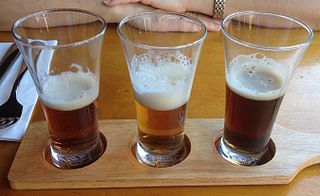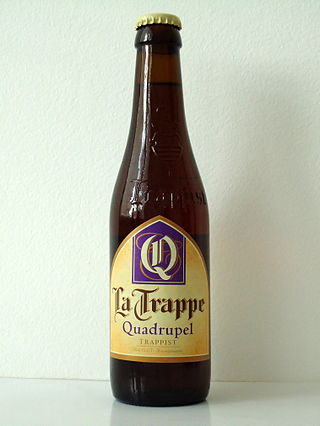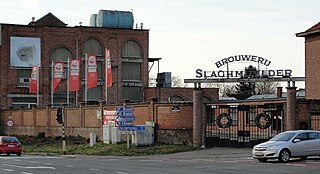
Pale ale is a golden to amber coloured beer style brewed with pale malt. The term first appeared in England around 1703 for beers made from malts dried with high-carbon coke, which resulted in a lighter colour than other beers popular at that time. Different brewing practices and hop quantities have resulted in a range of tastes and strengths within the pale ale family.

Pale lager is a very pale-to-golden-colored lager beer with a well-attenuated body and a varying degree of noble hop bitterness.

Old ale is a form of strong ale. The term is commonly applied to dark, malty beers in England, generally above 5% ABV, and also to dark ales of any strength in Australia. It is sometimes associated with stock ale or, archaically, keeping ale, in which the beer is held at the brewery. In modern times, the line has blurred between Old Ale and Barley wine.

Trappist beer is brewed by Trappist monks. Thirteen Trappist monasteries—six in Belgium, two in the Netherlands, and one each in Austria, Italy, England, France, and Spain—currently produce beer, but the Authentic Trappist Product label is assigned by the International Trappist Association (ITA) to just ten breweries which meet their strict criteria. As of 2021, Achel is no longer recognized as a Trappist brewery because it does not have any living monks.

Bitter is an English style of pale ale that varies in colour from gold to dark amber, and in strength typically from 3% to 5.5% alcohol by volume.
Unibroue is a brewery in Chambly, Quebec, Canada, that was started by Serge Racine and Quebec native André Dion. The company was purchased by Sleeman Breweries Ltd. in 2004, which was itself taken over by Sapporo in 2006. The company was incorporated in 1993 and is the first of three microbrewing companies in Greater Montreal area, both chronologically and in terms of sale benefits.

Duvel Moortgat Brewery is a Flemish family-controlled brewery founded in 1871 in the Antwerp Province (Belgium). Its strong golden pale ale, Duvel, is exported to more than forty countries. Duvel is Brabantian, Ghent and Antwerp dialect for devil, the standard Dutch word being duivel[ˈdœy̯vəl]. Other popular beers include Maredsous and Vedett.

Chimay Brewery is a brewery at Scourmont Abbey, a Trappist monastery in Chimay, Hainaut, Belgium, one of the thirteen breweries worldwide that produce Trappist beer. They make four ales: Chimay Rouge, Chimay Bleue, Chimay Blanche, and Chimay 150; and one patersbier for the monks. The monastery also makes four varieties of cheese.

Westmalle Brewery is a Trappist brewery in the Westmalle Abbey, Belgium. It produces three beers, designated as Trappist beer by the International Trappist Association. Westmalle Tripel is credited with being the first golden strong pale ale to use the term Tripel.

Beer in Belgium includes pale ales, lambics, Flemish red ales, sour brown ales, strong ales and stouts. In 2018, there were 304 active breweries in Belgium, including international companies, such as AB InBev, and traditional breweries including Trappist monasteries. On average, Belgians drink 68 liters of beer each year, down from around 200 each year in 1900. Most beers are bought or served in bottles, rather than cans, and almost every beer has its own branded, sometimes uniquely shaped, glass. In 2016, UNESCO inscribed Belgian beer culture on their list of the intangible cultural heritage of humanity.
The term dubbel is a Belgian Trappist beer naming convention. The origin of the dubbel was a strong version of a brown beer brewed in Westmalle Abbey in 1856, which is known to have been on sale to the public by June 1861. In 1926, the recipe was changed, and it was sold as Dubbel Bruin. Following World War Two, abbey beers became popular in Belgium and the name "dubbel" was used by several breweries for commercial purposes.

De Koningshoeven Brewery (Brouwerij de Koningshoeven) is a Dutch Trappist brewery founded in 1884 within the walls of Koningshoeven Abbey (Abdij Onze Lieve Vrouw van Koningshoeven) in Berkel-Enschot (near Tilburg).

Brewery Ommegang is a brewery located near Cooperstown, New York, United States, that specializes in Belgian-style ales.

Beer styles differentiate and categorise beers by colour, flavour, strength, ingredients, production method, recipe, history, or origin.

A Quadrupel is a type of beer, with an alcohol by volume of 9.1% to 14.2%.

Jopen is a beer brewery from Haarlem, Netherlands. Jopen's beer is a result of the work of Stichting Haarlems Biergenootschap, which was founded in 1992. The mission of the Biergenootschap is to re-create traditional Haarlem beers and bring them to the commercial market. Two recipes were found in the Haarlem city archives that were used as a foundation for two initial beers. The first one was a recipe from 1407; the recreation of this was named Koyt, a gruit beer.

Alvinne is a small brewery in the hamlet of Moen near the Belgian city of Zwevegem, founded in 2002.

Beer in Scotland is mostly produced by breweries in the central Lowlands, which also contain the main centres of population. Edinburgh and Alloa in particular became noted for the export of beer around the world in the 19th century.

The Slaghmuylder Brewery is a small brewery in Ninove, Belgium. It was founded in 1860 and is still run by the same family.

Bosteels Brewery is a brewery in Buggenhout, Belgium. The brewery was founded in 1791 and was owned and operated by the same family. Bosteels brew three beers: Tripel Karmeliet, DeuS, and Pauwel Kwak. In 2019 a new beer was added for the first time in 17 years; Monte Cristo.


















